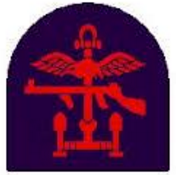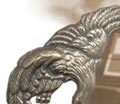 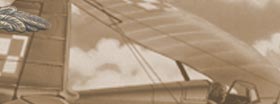  |
|||||||||||||||||||||||||||||||||||||||||||||||||||||||||||||||||||||||||||||||||||||||||||||||||||||||||||||||||||||||||||||||||||||||||||||||||||||||||||||||||||||||||||||||||||||||||||||||||||||||||||||||||||||||||||
|
| |||||||||||||||||||||||||||||||||||||||||||||||||||||||||||||||||||||||||||||||||||||||||||||||||||||||||||||||||||||||||||||||||||||||||||||||||||||||||||||||||||||||||||||||||||||||||||||||||||||||||||||||||||||||||||
They left Greenock on 15th September and arrived in Gibraltar six days later for a twenty-minute layover before setting sail for Algiers where they disembarked to a Polish Reception Camp at Oved-Kerma about 15km from Algiers (Al-Jazair). On the 16th September, they received new orders and on the 24th October moved to a Polish camp at El-Biar in the outskirts of modern Algiers. After a few days rest the unit had a day of independent activity that consisted of:
On 17th October, the Troop moved out and by truck, cars and motorcycles and headed for an area close to Philippeville (now called Skikda) where there was a recreational camp called Maison Carreé (now called El Harrach). (In 1945 the camp was used as a temporary refugee camp for Displaced Persons and later the area became a battle-ground between French and FLN troops during the Algerian war). Here, they stayed until 25th October before being moved to a transit camp 6km from Philippeville and left on the 28th October at 1215 for another transit camp at Ville D’Oran just north-west of Algiers arriving after a three-and-a-half-hour journey. The next day at 0900 they left for Philippeville in pre-preparation for embarkation. On 30th October at 0800 the unit left for Valetta via Malta. Throughout their constant movements, the unit of 11 officers and 81 men had to ship their arms with them. The weapons consisted of:
On 1st November at 0930 they arrived in Taranto in southern Italy. Originally, there were five camps in the area to handle the disembarkation of II Corps. II Corps HQ had been established in a hilltop complex above Mottola and handled the constant relocation of formations within the encampments. The camps were named:
By 1630 the company had left Taranto en route overnight and by 0700 on 3rd November had arrived in Molfetta about half-way between Bari and Adria on the Adriatic coast. Here were minor personnel changes with some additions and departures. The Troop was in preparation for moving to the front with weapons audits and company reviews. On 12th December 1943, the Troop was ready for joining the line. At 0700 they moved off for Barletta along the coast road heading for Via Foggia, Lucera, then Vinchiaturo located in the middle of the country and finally arriving further north at Bojano at 1800. Accommodation within the town had been found where they received further orders to leave the following morning for Capracotta and were to leave at 0900. These movements were part of the Sangro River front with the unit sandwiched between the main Polish Army to the west and the Canadians and British to the east. At the time, there were two concentrations on the fronts at Anzio and Monte Cassino. Geographically, the area was flanked by steep mountains and deep gorges with fierce watercourses where villages were located on hilltops due to the terrain. It was also middle of a bitterly cold winter that has been described as so ‘atrocious’ that the fighting had ground to a halt. Capracotta was a strongpoint along this sector of the line. Once in place, the Troop formed reconnaissance or recce patrols around Capracotta. Pescopennataro, a picturesque ski resort and Castel del Guidice were the main areas of activity with patrols going out at 1800 and 2330 and covering up to 60km in some cases. 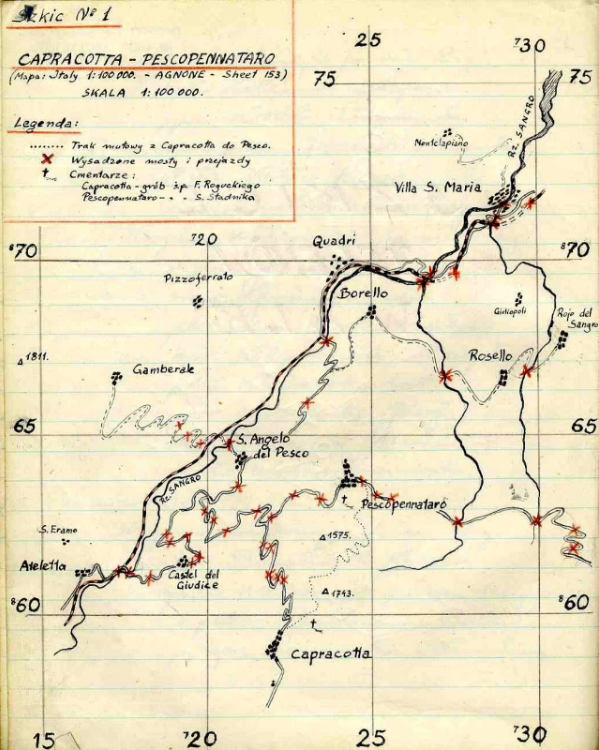
On the 14th December 1943, the patrols switched to covering Ateletta, St. Aveno, Petrili and S. Angelo del Pesco using the river Sangro as a natural boundary/ frontline. On 20th December, the unit was deployed to intercept two mountain trained Jäger companies that were planning to attack British artillery battery near Capracotta. Despite heavy artillery fire the Germans had surrounded the Poles who held their positions within the village in a nine-hour standoff. This pattern of patrols and skirmishes continued until the spring of 1944. Some patrols were sent further afield to Villa Santa Maria and Borello. On 23rd December 1943, an British unit joined them and the company was reviewed by General Keightley who was to command the British Eight Army’s V Corps and congratulated the turnout and commitment by the Troop. From 24th December, joint patrols with the British started at S. Angelo del Pesco with one patrol augmented by Belgian 10 Commando and joined by Major Goode and an artillery officer Major Coatsworth focussed on the river Sangro making sure the area was secure. Most skirmishes were to the east of the units. As the new year of January 1944 broke, the Troop was settled into regular patrols in their sector of the river Sangro. Now deep winter, the troops had to patrol walking through deep snow in hilly country with inadequate winter fighting equipment. Having to walk several kilometres before they could set up ambushes in the rock formations was debilitating and many patrols were out in these conditions for up to 48 hours as the unit records show. Blizzards and great snowdrifts hampered communications and ability to operate with some positions out of contact for significant periods of time. Capracotta became a supplies dump with 14-20 days’ reserve stocks piled in the area, but despite this daily rations were sometimes cut by 30-50%. When not on patrol, the Troop was strengthening positions with sandbags and kilometres of barbed wire and this summed up most of January’s activities. 80% of the patrols started to branch out along the river Sangro and by 10th January 1944 the unit of 11 officers and 74 men was withdrawn for R&R moving to Pescopennataro and finally Agnone. On 11th January 1944, the Troop was ordered to leave at 0600 towards Vinchiaturo, Jelsi, Motta Montecorvino with the final destination Lucera where accommodation had been found. On 12th January at midday in the Corps camp at Villa Lotorno near Troia just south of Lucera, the Troop was met by the commander of 10 Corps and the 56 London Division. The next day was spent stock-taking and for some sending messages to ‘home’. They were also aware they had been defending the line against captured or forced Polish conscripts into the German army. The next day the Troop was ordered to prepare for moving out and head for Sessa Aurunca near Naples. They would join the 56 London Brigade who had captured Naples on 22nd September 1943. Instead, they were then posted to Lauro close to the river Garigliano and arrived on 16th January 1944. There were only two coastal zones which were suitable for offensive operations: The Adriatic and the Tyrrhenian which led straight to Rome. The Tyrrhenian had two corridors in its southern section on either side of the trackless massif Monti Aurunci. The coastal corridor was too narrow for effective offensives. The Liri Valley was the only viable option. Allied forces had attacked the valley three times in January 1944 with the first offensive carried out by 2 American Corps that was halted at the Cassino hills with the Monte Cassino Monastery lying to the south west and the focal point of the Gustav and Hitler Lines. The second attempt was by the 2 American Corps and the French Expeditionary Corps made up of many African units was also unsuccessful. The third attempt would be in March and led by the New Zealand Corps. The battle for Monte Cassino by Polish II Corps was brutal. On the 17th January 1944, some sections within the Troop requested relaxation while others were providing artillery observation duties or patrols along the river Garigliano in support of the 56 London Division. All operations were making little impact on the Gustav Line and the Hitler Line. Heavy artillery fire pounded the German lines day and night. All action was dictated to by the local topography of ridges, ravines and any areas of flat land was heavy clay. The Commandos’ were in support of the British division tasked with breaking through to Castelforte with 40 RM Commando held in reserve along with the 2/5 Queens Guard. The Troop were tasked with a variety of duties including using their 2lb artillery pieces which added to the bombardment at 1200 and 1800. 
On 18th January 1944, the Troop moved out of Lauro to the front line at 2200. The whole brigade was to use Suio Alto as a base. Under heavy artillery fire, the commandos used a drainage channel and crossed the river Garigliano at 2030 opposite an orange orchard under intense fire. Having crossed the river and followed a marked path set up by the 2/6th Queen’s Regiment they found the orange orchard to be heavily mined. They moved through the village and set up a defensive position just north of the village which they occupied until 19th January due to the Queen’s Royal Regiment failed to meet the rendezvous leaving the Poles to defend the village. Platoons were given orders to attack what was thought to be heavily defended positions up a slope towards Monte Natale held by battle hardened units which they took without too much resistance. At dawn, they were relieved by 40 Commando. Later in the day, a platoon was sent into Zinto valley skirting a dominant ridge running eastwards above the river. Led by Captain Stanislaw Wołoszowki, they captured a German section after a fire-fight and came under heavy fire from German mortar positions positions higher up the ridge. Unfortunately, Captain Stanislaw Wołoszowki died after German positions opened mortar fire on them. Lt. Czynski led a patrol into the Valle Zinto overran a mortar team in a ravine and captured a forward artillery observation post. The summit had to be held and the section fought off several attempts to regain the position with hand-to-hand fighting. When the third section under Lt. Zalewski was committed to support Lt. Czynski, the Germans withdrew. In this sector the Brigade were tasked to find another route into or around Castelforte. The area faced a barrage of German mortar fire with high casualties with the Commandos losing 4 killed and 22 wounded in their attempt to capture and clear Monte Valle. The tactics were later described as ‘reminiscent of the tactical ham-fistedness of the World War One’ (Ellis, 1984:76). The goal had been to take Monte Natale and Monte Rotondo within the first 24 hours and the German resilience had been severely underestimated. The Commandos had again been operating with 40 Commando and the 2/5 Queen’s Brigade who had suffered heavy casualties as they were not trained or equipped for infantry fighting. On 19th January 1944, the unit was moved to just down the road eastwards to Tibaldi and stayed until 20th January. At the roll-call were 10 Officers and 47 serving men. The action had inflicted a significant level of casualties. Those killed were Captain Stanislaw Wołoszowki and privates Decker, Klajber, Złowinski. The wounded were listed as: Lance-Sargent Habdas, Privates Wojciski, Kubisiak, Lance-Sargent Blasiak and Stysz, Cadet-Officer Jadimouicz, Kowalski, Młynek, Kwieciem, Gendera, Korałyk, Deorocki, Banko, Kulcycki, Wojciechowski and Kejzman. The unit was in a holding position with the Brigade holding onto a wide section of the front. Weather conditions were not good with weapons easily drenched and the river was running high. Small patrols entered the Zinto valley, but for the next 24 hours due to the state of the unit held in reserve which gave them time to hold a short service in the memory of those recently killed in action. On 21st January 1944, the Commandos were moved back to Lauro. Along this sector, counter-attacks and redeployment by German units meant troops of the 94th Division were not adequate to maintain the strongholds with units being brought in from reserves including administrative staff. From 19th to 24th January 1944, the fighting along the Garigliano was fierce with counter-attacks from both sides. The Green Howards took Trimonsuoli while the 1st Yorks and Lancasters took Monte Natale despite the fierce resistance and counter-attacks. Hanging onto these positions was at best tenuous and Monte Natale was won, lost and regained over the next few days, but almost all the Brigades within the 56 Division were exhausted and low in strength. At Lauro, the Commandos supported patrols in the Suio and Castleforte areas that was later extended into Santa Agata and acted as a ‘rear-party’. On 26th January 1944, the Commandos re-joined the 56 London Division. To the north, the 46th and 56th Infantry Divisions were holding onto positions opposite the heavily defended Gustav Line. The winter cold and exhaustion had compromised the fighting strength. It was proposed the No.9 and No.43 Royal Marine Commandos supplemented with 4th Belgian Commandos would join the 56th Infantry Division in a counter-attack. The Polish Commandos were tasked with supporting the attack on Monte Tuga with an SS Division against them. No.43 Commando followed by No.9 Commando scaled the mountainside under the cover of diversionary artillery shelling with infantry support. After heavy fighting for a day and a half, Mont Ornito and Point 711 had been captured despite the Commando HQ being mortared with some casualties. Monte Faito failed to be captured. These actions were in the most appalling winter conditions where all munitions, food and water had to be carried on the soldiers backs since the terrain was too steep for mules and the Germans were in well-fortified positions. The Commandos were relieved by 5th Royal Hampshire’s and it was not until the spring of 1944 that Mont Faito was eventually captured by the French Expeditionary Corps. From 31st January until 5th February 1944, the Troop was stood down for rest and recovery. There were excursions, but the focus was on further training with shooting range practice and medical check-ups taking place prior to moving to San Andrea del Vico near Naples for specialist training, shooting practice and beach landings. The unit was down to 9 officers and 54 servicemen. To the north, the Anzio landings had become bogged down due to poor US leadership with opportunities lost that was holding up four Allied divisions progress towards Rome. The Polish Commandos had been notified they may be reassigned to the beachhead. The Commando unit was to be re-assigned to join II Polish Corps and on 4th April 1944 taken by truck to Busso where General Sosnowski awarded medals and decorations for their gallantry. The Virtuti Militari, one of the highest awards were made to three recipients with Silver Cross of Valour to 16 of the ranks and bronze Cross of Valour to three ranks. The Military Medal was awarded to Lance-Corporal Rozen. By 13th May 1944 the unit had increased its strength to 16 officers and 78 men through being supplemented with battle-hardened men from the desert campaign. Four attempts had been made on Monte Cassino and the spring offensive needed to break the stalemate along the front. Operation Diadem was based around the II US Corps advancing along Route 7 coast road towards Rome. The French Corps would attack through the Aurunci Mountains to the west of Cassino to protect the US flanks. The British VIII Corps would cross the river Garigliano and assault the Gustav Line and then advance on the Hitler Line, surround the area and then advance up the Liri Valley towards Rome. The II Polish Corps would cross the river Rapido and isolate Cassino and then link up with the British. 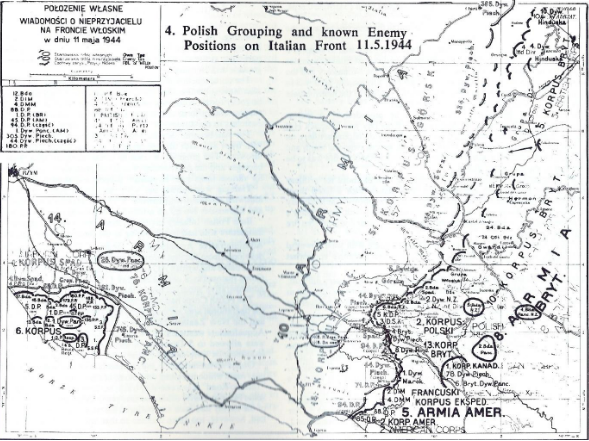
On 16th May the Polish Troop were positioned at Inferno (exact location not known) in preparation for action at Castellone. The Troop was assigned to the 5th Kresowa Division led by Lt. General Sulik. 6 Troop were attached to the 15th Poznan Lancers and tasked with capturing Colle San Angelo via Monte Castellone ridge. Engagement started at 0700 towards the Colle San Angelo and at the second attempt, captured their target by 1300. It was a difficult assignment where shortages of ammunition resulted in rocks being thrown and not once did the Polish troops falter. Heavy mortar fire inflicted 19 casualties and killed Sgt Bradowski and Lt. Zemanek. The Troop was down to 7 officers and 45 men when they left Colle San Angelo and had taken part in one of the bloodiest engagements of the campaign. 
On 19th May 1944, the Commandos were still attached to the 5th Kressowa Division and remained at ‘Inferno’ where food and water were in short supply. The battle of Monte Cassino would rage on until 27th May. On 20th May 1944, the Troop assembled at 0900 and given orders to reassemble at 1230 to be transported to Capriatti. At roll call the next day the Troop was 10 officers and 54 men with 2nd Lt Luks, Lance-Corporal Lubanski, Sergeant Szablonski, Corporal Lindner, Staff-Sergeant Kazmarek, and Corporal Kejzman forming a ‘rear party’ where they stayed until 3rd June when they were shipped off to Oratino with 111th Company made up of Italian volunteers recruited to protect local bridges. It gave the Troop an opportunity to recover with those wounded at Monte Cassino returning to the line. On 21st June 1944, the Troop moved eastwards to Monte Pagno before moving onto Porto San Giorgio just south of Ancona on the Adriatic coast with more men being released from hospital. The mission for the II Corps was to capture Ancona, then cross the river Musone and Chienti towards the Gothic Line. In the run up to the launch of the battle for Ancona the Troop were first moved to Montelupone before moving on to just south of Castelfidardo. The Troop was now 8 officers and 66 men and were attached to the 3rd Carpathian Division and were tasked to capture and clear a location called Villa Virginia tasked by 2nd company and Villa Terni by the 1st company. On the 9th June 1944, the Troop were in operations with the 111th Company who were one of many Italian units now fighting alongside the Allies. Their target was Monte Freddo which fell after a short skirmish. Villa Terni became a short-term operating base for the 1st company with patrols securing the area with the second company doing similar activities at Villa Virginia. 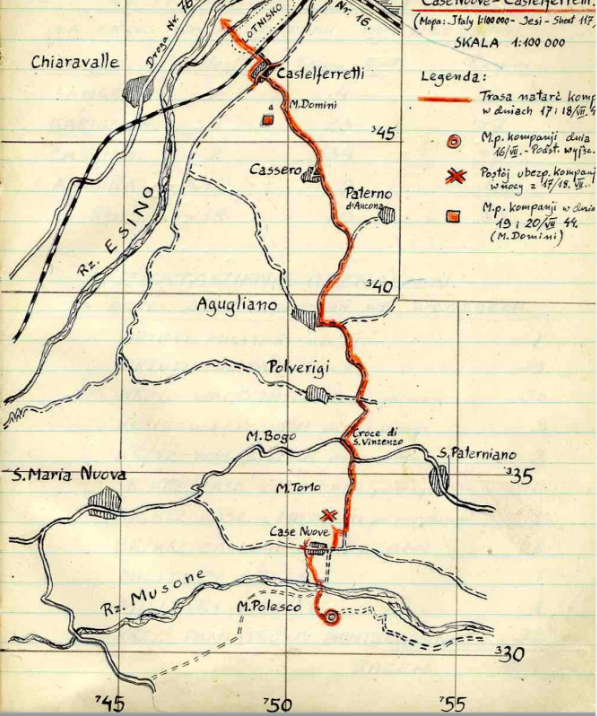
The troop joined the 2nd Polish Armoured Brigade and crossed the river Musone opposite Case Nuove that was heavily defended. The Troop crossed an exposed maize field towards the centre of the village and sustained some casualties with 4 killed. Section 1 took the right flank with 2nd Section taking the left flank towards brickworks the other side of a small ravine and protected by heavy defences where the bridge had been blown. The 3rd Section moved across the space towards a house and then settled in opposite the church. It took two days to clear Case Nuove and needed tank support to breakthrough and clear any resistance. Company HQ had been set up just north of the village in the shadow of Mont Torto. To the East, the II Corps had relieved the 4th Indian Division on 13th June and had been joined by General Umberto Utili’s Italian Corps of Liberation and had made progress towards Ancona. Anders halted the advance and deployed his divisions in order to confuse the Germans that would enable the 5th Kresowa Division to sweep inland on the left flank and bypass Ancona by taking the coast road to the north of the city. This plan by General Anders sending the 5th Kresowa Division and the 7th Hussars inland would throw the German planners. For the Commandos, their progress up Adriatic coast was to capture Fermo and Pedaso before their progress was halted at the Chienti river just south of Ancona. On 18th July, the Troop hitched a ride on tanks that took them to the Cross of San Vinzenzo, Agugliano, Cassero and finally set up company command post within view of Castelferretti at 1600. The Troop were down to 7 officers and 58 men. They were tasked to dig in on Monte Domini as an observation post where the platoons were resting prior to further orders or doing recce’s over the river Esino. They crossed the river Esino in support of II Corps before being pulled back to Montefano. Next the Troop were moved to Numana on the coast with a rear-unit sent to Montelupone. The stay at Numana was short and on 18th July senior officers went to Camerano for a briefing. The battle for Ancona required the close cooperation between infantry and engineers, the 7th Hussars (tanks) and II Corps. Fighters and fighter bombers were being used to target artillery and mortar sites while using every opportunity to strafe enemy convoys and vehicles. An Italian partisan unit, the Maiella band also had a role in the battle. Once over the river Esino, the 278th German Infantry Division was practically destroyed with 2,500 men trapped in the city. The final battle for Ancona lasted two days and the II Corps fought two battles to secure the port. The port of Ancona was important as a supply point for the 8th Army to progress to Arezzo. The battle for Ancona had lasted from 16th June until 18th July 1944. II Corps continued their offensive to breach the Gothic Line in Operation Olive. The Corps was under strength when they attacked Pesaro but caught the German parachute regiment withdrawing. With Canadian 1 Corps and the British V Corps had managed to breach the eastern flank of the Gothic Line. The II Corps spent the latter part of August being refitted and replacing damaged equipment and integrating Polish POW’s having lost 2,150 in casualties capturing the port of Ancona alone. II Corps was held in reserve due to the level of casualties that no other units had experienced (Holland, 2008). It was also a difficult period for all Poles fighting for the Allies since the Warsaw Rising ’44 was taking place with special squadrons flying out of Bari at great personal cost. On 3rd August, the Troop had left Numana for Ortona by trucks to supplement II Corps. The Troop had suffered exceedingly high casualty rates and needed replacements to keep them to full operational strength. On 25th August, the Troop now became the 1st Independent Commando Company. The Troop was now one of five Troops attached to the 2nd Commando Motorized Battalion. At a review of the Troop, General Sosnowski awarded numerous medals and decorations for their gallantry and unwavering bravery shown throughout the Italian campaign. For the Commandos, their war was almost over and had shown defiance and determination even when the unit was being decimated by casualties. It was a theatre of war that was exceedingly bloody with widespread damage inflicted across the country as the Germans retreated or were pushed back. For the Italian campaign veterans, they felt their war was overshadowed by the main drive for Germany.
For our freedom and yours - Za naszą i waszą wolność
PostscriptHalf of the Troop were attached to 2nd Special Service Brigade. In the process of reorganisation the Troop had grown to 18 officers and 236 men, many of whom were former Polish POW’s from the German Army who had been forcibly conscripted. Some 20,000 troops were recruited in this way. While they were reforming, and building up to fighting strength, the planning for the Spring Campaign was underway with Bologna as the prime task. The Eighth Army had been reduced to about a month’s operational capability with the Fifth Army down to about fifteen days. Ammunition was in short supply and limited even artillery cover. Although Bologna was the prime objective, it was also necessary to prevent the withdrawal of German units to fight on other fronts. Poor weather conditions hampered both ground and air offensives until March. The weather assisted both sides in regrouping and for II Corps it also enabled Italian Combat Groups to train and join the line with the Cremona Group as part of the Eighth Army. The terrain ranged from high broken mountains through to the foothills of the Appenines and the flat Po Valley. The Po Valley was characterised by small flat fields and vines making it an infantry sector since tanks would have some difficulty. The tactics were to ‘run with the grain’ or move in parallel to the rivers and canals that would reduce the need to keep crossing them.1st Independent Commando Company had been ‘wintered’ in Ostuni to recuperate, train and integrate newly recruited troops. It was a lengthy process since there was a shortage of uniforms and weapons. By 2nd March 1945, the Troop had grown to 34 Officers and 667 men. The Yalta Agreement was a bitter blow to the troops and at one stage thought the whole II Corps would be withdrawn, however Allied commanders could not replace them and needed them in support of the Eighth Army. As the month of March closed, the Troop were now 38 officers and 828 men were given orders to move up to the front at Bologna. On 7th April 1945, the unit left Ostuni via Foggia and Ancona to join II Corps. Operation Buckland, the battle for Bologna was fought between 9-21 April 1945. It started with a massive air and artillery bombardment. Due to the shortage of equipment the Commando Battalion which was part of the new Armoured Division was used as an infantry unit. On 11th April, they arrived in Forli and then based at Villagrappa while the main action by the Corps was to capture Imola. They were then dispersed to different localities around Faenza and Castel di Guelfo and on the morning of 21st April 1945 the 9th Carpathian battalion entered Bologna. The Commando Battalion and the 3rd Division were then tasked with actions in the Po valley to encircle retreating troops and captured the towns of Castel Maggiore and Corticella. Next day II Corps were removed from the line. Their war was over. The Commando battalion were moved to Porto Civitanova and stayed until 1st October 1945 when they moved to an army camp at Macerata where there were now 63 officers, 79 non-commissioned officers and 954 men. Here, the unit was in the process of being de-commissioned and although basic military training continued to keep the men active and to avoid boredom a programme of sport and cultural activities took place. They remained in Macerata until 1st July 1946 where the final roll-call had 68 Officers, 54 non-commissioned officers and 823 men. The return trip was by rail. War in Europe was largely over despite civil war in Eastern Poland. It had become a period of mass expulsions in eastern and central Europe, displaced people and wide-spread starvation. It was a dark period where millions suffered. The Commando Battalion left Citanova on 7th July by train that took them from the Adriatic coast through the Brenner Pass into Austria, through France and boarding ships at Calais boind for Dover. They arrived at Dunscombe Park near Helmsley on 6th July 1946. An inconspicuous day for many, but not for the Poles. Britain formally withdrew the recognition of the legality of the Polish Government in Exile on 6th July 1945. The charade of ‘free elections’ in Poland was to follow with the imposition of Communist Government and the onset of the ‘Cold War’. The final insult was with recognition of the new regime’s sovereignty by the Allies, left the Poles-in-exile in effect a mercenary force. Each of the armed services was responsible for the de-mobilization and transfer of armed combatants into the Resettlement Corps (PRC). An Act of Parliament was passed in February 1946 and in the middle of March Ernest Bevan formally advised all Poles could not be maintained in Britain (Cynk, 1998). (Polish Resettlement) The camp at Dunscombe Park, Helmsley Yorkshire had been used prior to the Normandy landings by Canadian Troops. During the war the hall had been used as a girls’ boarding school. The camp had now become part of a network of camps for the PRC where re-training for civilian life would take place. The former Commandos were moved to Harland Way Camp, Cottingham near Hull on 1st September 1946 and then to Wymersley Road Camp, a former military and POW camp where they were billeted for almost three months before being transferred to Watton Camp near Driffield over the 7th to 9th December 1946. Here they remained until 1st June 1947 when the unit was disbanded. The shabby dealings by the British post-war governments has largely been forgotten, but as younger generations research their genealogy, the heroism and dedication by the Poles will return to its rightful place. Selected Bibliography:
Site hosting by Paston. | |||||||||||||||||||||||||||||||||||||||||||||||||||||||||||||||||||||||||||||||||||||||||||||||||||||||||||||||||||||||||||||||||||||||||||||||||||||||||||||||||||||||||||||||||||||||||||||||||||||||||||||||||||||||||||
